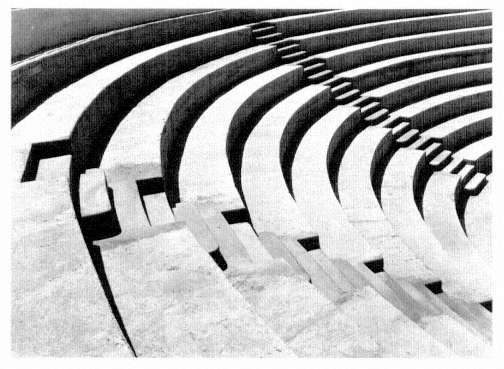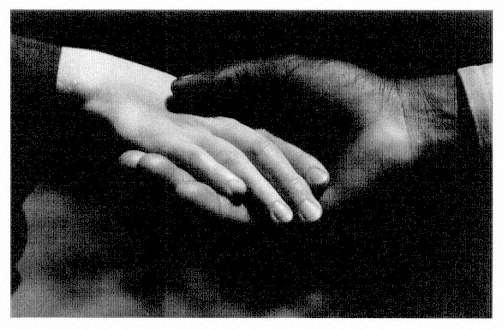Women in Group f.64
The members and associates of Group f.64 were generally well educated in the ways of commercial photography by the early 1930s. They were mainly self-taught, although two were experienced darkroom assistants to more mature photographers (Noskowiak for Weston, Mary Jeannette Edwards for Lange). Their ages in 1932 ranged from forty-nine (Edwards) to twenty-one (Brett Weston), but most were in their thirties or earl), forties. They all tended to accept the authority of Edward Weston's years of photographic experience. And, notably, women were strongly represented among them.
The study of Group f.64 invites speculation about why so many women were empowered through their association with a predominantly male friendship group that might have ideologically subjugated women as darkroom assistants and mere receptors for male creativity.
Very likely the acceptance of women into the group was made possible after World War I by the emergence of the "New Woman," demanding the right to work and vote. As early as 1913 eager women writers explained admiringly that Anne Brigman and Laura Adams, a successful San Francisco portrait photographer, could be independent in photography, as this work was "suitable" for women, needing no large capital outlay, no long schooling or learning beyond the usual education of women. Women's "intuition" was cited as justifying their special talent for portraiture, particularly—it comes as no surprise—of children.[34]
Imogen Cunningham, on her own after European study and schooling in chemistry, began an innovative and provocative series of male nude studies of her husband, Roi Partridge, who was pictured faunlike in settings of the Washington hills and mist-covered lakes. For financial support she also pursued studio portrait work, photographing children and their families, while continuing to keep in touch with the magazines and shows that led the way toward modernism (Fig. 98).[35] Cunningham's direct, no-nonsense personality led to her willful decision in 1934 to go to New York despite Roi's disapproval. The trip resulted in divorce. (Anne Brigman had taken a similar trip, with similar results, in 1910.) Cunningham continued executing portrait commissions to support her twin sons and a slightly older son, all under the age of nine. Perhaps because she assumed these responsibilities, her male colleagues considered her a professional, a fine art photographer, an equal, and a friend. In 1928 Weston sent her a gloriously complimentary letter, telling her that her photographs were the best in the San Francisco salon.[36] Possibly her sense of fun and her sharp wit gave her powerful weapons in any struggle for parity with men in the group. Cunningham was always treated with respect.
Sonya Noskowiak's initial position in the group was as a dependent. Her progression from receptionist in Johan Hagemeyer's Carmel studio, where she met Weston, to Weston's general helper, darkroom assistant, and then model, mistress, and companion is well known. The daybooks chart the circumstances of their relationship as well as Weston's egocentric appreciation of Noskowiak's photographs in January 1930, almost her very first: "A negative of Neil's hands, the back of a chair, and a halved red cabbage. Any one of these I would sign as my own. And I could not give higher praise. She is a surprise."[37]
Consuelo Kanaga was an unusual participant in the f.64 exhibition of 1932. Young, naive, and working on her own for newspapers, she was dependent on her patron and sponsor, Albert Bender, who was also important to the careers of many members of Group f.64. She knew them but was shy, reluctant to become involved. In her letters to Bender she repeats her reservations and doubts.[38] Even her early pictures were of social themes. For example, she made black-and-white photographs illustrating blacks and whites holding hands (Fig. 99). Her 1928 portrait Frances , of a sweet-looking black

Figure 98
Opposite, top : Imogen Cunningham, Mills College Amphitheater ;
ca. 1920. © 1978 The Imogen Cunningham Trust.

Figure 99
Opposite : Consuelo Kanaga, Untitled (Hands) , 1930. The Brooklyn Museum, gift of
Wallace B. Putnam from the Estate of Consuelo Kanaga through the Lerner-Heller Gallery.
child, was considered out of the ordinary, as the Bay Area black population was then small. Unlike Arnold Genthe, who sought the exotic and alien "other," Kanaga pictures Frances as a child who happens to be black. Kanaga's picture conveyed an innocent message of racial understanding in which potential conflicts are easily resolved. Kanaga was interested in the way black-and-white photography could make social statements; only in passing did she consider photography a fine art.[39]
When Alma Lavenson went to Carmel in 1930 to meet Weston, he urged her to reconsider the soft-focus atmosphere of her prints.[40] She was self-taught, and like the others in Group f.64 she had learned the craft thoroughly. She renovated a childhood playhouse as a darkroom and created photographs by first visualizing them in her mind. She accompanied friends who painted and etched scenes at the Oakland waterfront, photographing that active port. Its warehouse buildings and ships' riggings became a favorite f.64 subject.[41] From the outset, Lavenson's pictures were successful in competitions.[42] Although she did not know other photographers at first, she did subscribe to camera magazines, and she had good equipment; her family, through a successful mercantile business, was well able to afford it. With letters of introduction from Albert Bender, a family friend, she met Imogen Cunningham, Consuelo Kanaga, and Edward Weston. Although her contact with Weston was most significant for her photography, Cunningham had greatest influence on Lavenson's activity as a photographer: "I met her in 1930, somehow or other we became close friends and we remained close friends until she died forty years later. I photographed with her and we travelled together. . .. She never criticized my work, she never praised it."[43]
These remarkable women were acknowledged as peers by their Group f.64 male contemporaries. Only later did a silence come to surround their work—a silence created by exhibition curators, art dealers, and photographic historians in the 1950s. Although Lavenson and Cunningham continued to live and photograph in the Bay Area, they were not singled out for solo shows until their careers were validated by their remarkably long lives. As Cunningham noted, she and other women photographers in their fifties were invisible; only when she reached seventy did she become a celebrity.[44]